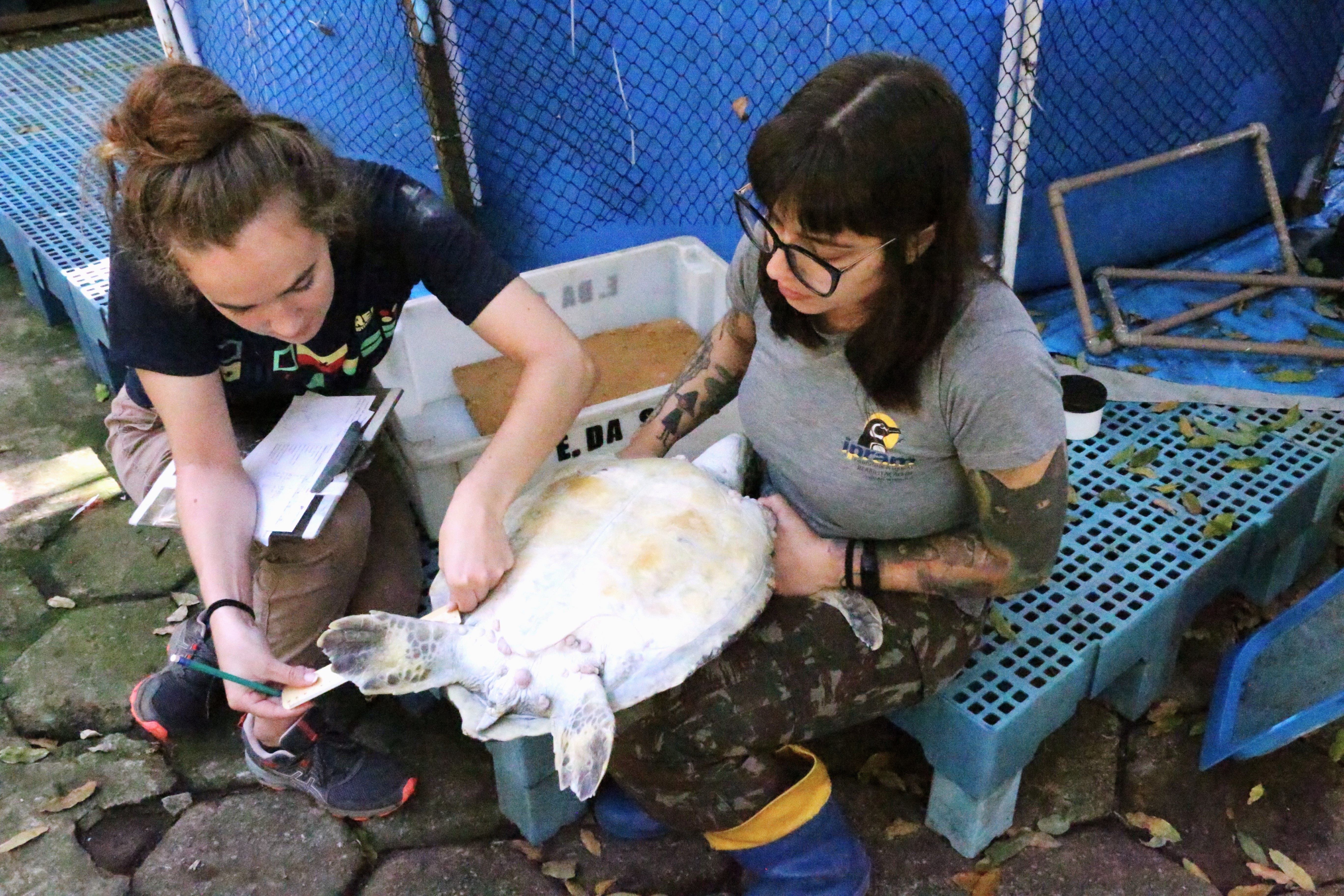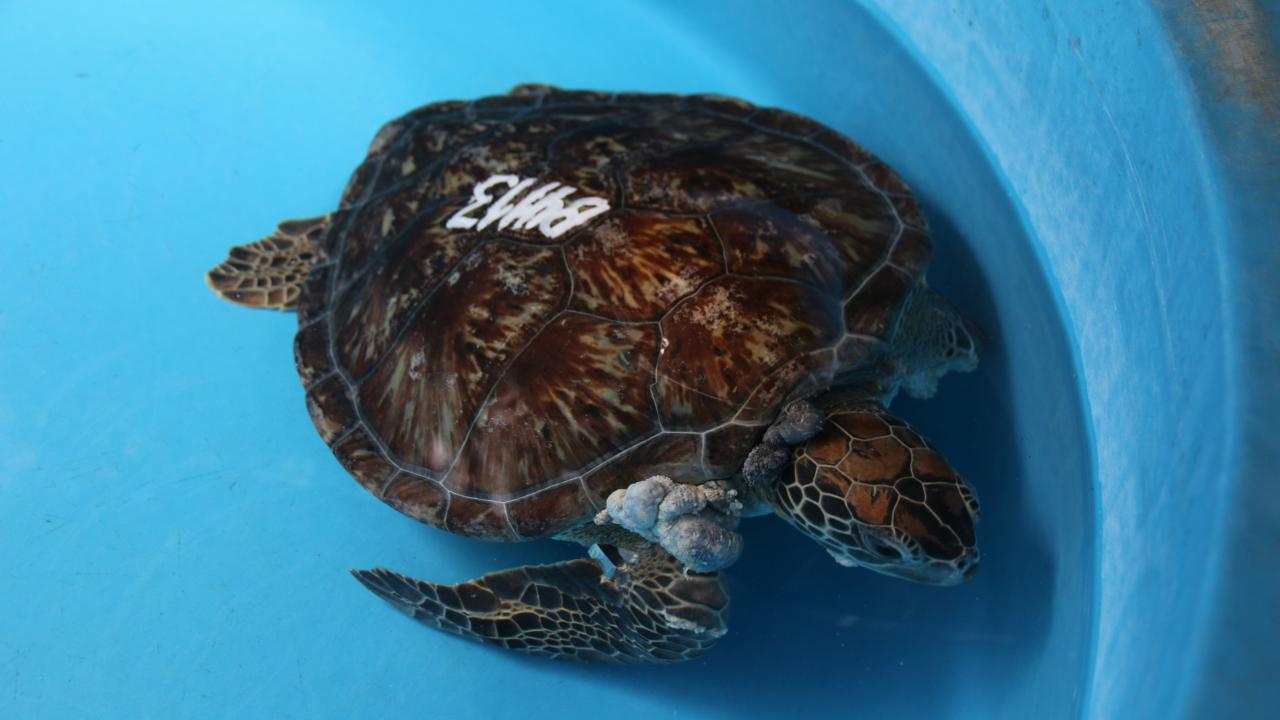A new epidemiological study of endangered juvenile green sea turtles in eastern Brazil suggests that factors such as water temperature, salinity and proximity to environmental stressors could trigger the development of a tumor disease associated with a herpesvirus.
The University of California, Davis, study, which was published in the open-access journal PLOS ONE, also found that the distribution of the tumors from fibropapillomatosis, or FP, can provide clues to better understanding the disease.
“FP is one of those things that has troubled scientists for a long time,” said senior author Marcela Uhart, a wildlife veterinarian with the One Health Institute at the UC Davis School of Veterinary Medicine. “It could be that where the tumors show up on the turtle’s body is not as random as we used to think.”
The disease was first documented in 1938, and cases began exploding in the 1980s. All sea turtle species are susceptible, but juvenile green sea turtles, which are endangered, represent the most cases and the highest disease severity.
The tumors caused by FP grow on the neck, eyes, flippers and limbs, and although they are not invasive, they may affect feeding, swimming and other activities.

Habitat may play a role
Although the disease is caused by a virus, the Chelonid herpesvirus 5, not all turtles infected with the virus will develop FP. The tumors tend to be more frequent in juvenile turtles that live near urban areas, which suggests that habitat quality may play a role in the progression of the disease.
“The presence of the herpesvirus is not sufficient for the disease to show up, so we need to explore what other factors may play a role in triggering tumor development,” Uhart said.
Seeking to better understand the disease, UC Davis researchers and experts from several Brazilian institutions studied the ecology of FP in green turtles on the coast of Espírito Santo, in eastern Brazil. This area is considered one of the global hotspots for FP, with more than 40% of the turtles presenting tumors.
One factor that may have contributed to the high prevalence of FP in Espírito Santo is the presence of metallurgical plants, which discharge large quantities of warm water into the sea. The warm waters near those plants are known to attract juvenile green turtles. Underwater surveys show that the average FP prevalence can reach 76% in those gathering areas.
The team of researchers looked at two datasets: daily beach surveys documenting stranded or dead turtles along 250 miles of coastline over four years, and a database about the size and location of tumors on 271 turtles from the same region.
The analysis found that turtles with marine leeches, which were previously suggested to transmit the herpesvirus, were four times more likely to have tumors. The findings also suggest that a combination of individual factors (age and body condition) and environmental factors (salinity, temperature and proximity to metallurgical plants) play a role in the likelihood of FP tumors.
Distinct patterns
The researchers also found there are at least three different patterns of FP, with tumors concentrating either in the front flippers, back flippers, or in other parts of the body. These patterns were also found to be influenced by the environment.
“The fact that there are these distinct anatomical patterns, which are linked to a suite of environmental factors, suggests that FP might behave in more complex ways than we previously thought,” said Ralph Vanstreels, an associate researcher with the School of Veterinary Medicine and lead author on the study.
The study suggests that looking at how the tumors are distributed on the turtle’s body can provide hints about what individual and environmental factors triggered the growths.
Researchers have long sought for the environmental factor that could best explain why FP is more common in some regions than others, but the results from different studies have often disagreed.
“Our findings suggest that we should look at this disease as a mosaic of anatomical presentations, and that perhaps these different presentations are associated with different environmental factors,” Vanstreels said.
Linked to global change
This information will be useful when trying to understand why the disease emerges and how to control it.
“If the trends continue, our expectation for sea turtle health is it will get worse rather than better,” Uhart said. “These factors are linked to global change.”
Sea turtles have existed for over 150 million years and play a key role in the ecosystem as they consume and transport nutrients and act as both predator and prey.
“Protecting these species is essential to ensure the health of our oceans, and understanding the recent increase in FP is an important part of this puzzle,” Uhart said.
Undergraduate student Alexis Durant from the UC Davis School of Veterinary Medicine contributed to the paper, as did researchers from Instituto de Pesquisa e Reabilitação de Animais Marinhos, Universidade Federal de Alagoas, Universidade de São Paulo, Universidade Federal de Alagoas, Instituto Argonauta para a Conservação Costeira e Marinha, Universidade do Estado do Rio Grande do Norte, Universidade São Judas, Universidade Paulista and Instituto Federal de São Paulo in Brazil.
Media Resources
Media Contacts:
- Marcela Uhart, UC Davis School of Veterinary Medicine, muhart@ucdavis.edu
- Emily C. Dooley, UC Davis News and Media Relations, 530-650-5807, ecdooley@ucdavis.edu
- Kat Kerlin, UC Davis News and Media Relations, 530-750-9195, kekerlin@ucdavis.edu
